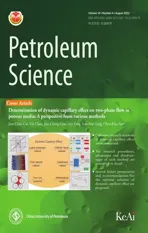A novel redox indicator based on relative abundances of C31 and C32 homohopanes in the Eocene lacustrine Dongying Depression, East China
2022-09-23ChongJingHiPingHungZhengLiHongZhngZhengZhi
Chong Jing , Hi-Ping Hung ,,c,*, Zheng Li , Hong Zhng , Zheng Zhi
a School of Energy Resource, China University of Geosciences (Beijing), Beijing,100083, China
b School of Geosciences, Yangtze University, Wuhan, Hubei, 430100, China
c Department of Geoscience, University of Calgary, Calgary, Alberta, T2N 1N4, Canada
d Geology Scientific Research Institute of Shengli Oilfield Company, Sinopec, Dongying, Shandong 257015, China
Keywords:paperBiomarkers C32/C31 homohopane ratio Redox conditions Dongying Depression
ABSTRACT A suite of oils and bitumens from the Eocene Shahejie Formation (Es) in Dongying Depression was geochemically characterized to illustrate impact of source input and redox conditions on distributions of pentacyclic terpanes.The Es4 developed under highly reducing,sulfidic hypersaline conditions,while Es3 formed under dysoxic, brackish to freshwater conditions. Oils derived from Es4 are enriched in C32 homohopanes (C32H), while those from Es3 are prominently enriched in C31 homohopanes (C31H). The C32H/C31H ratio shows positive correlation with homohopane index (HHI), gammacerane index, and negative correlation with pristane/phytane ratio, and can be used to evaluate oxic/anoxic conditions during deposition.High C32H/C31H ratio(>0.8)is an important characteristic of oils derived from anoxic environments, while low values (< 0.8) indicate dysoxic conditions and extremely low values (< 0.4)indicate strong oxic conditions. The C32H/C31H ratio can be applied for deposition condition diagnosis because carboxyl group of C32 hopanoic acids might be reduced to C32 homohopanes under anoxic conditions,and oxidized to C31 homohopane under oxic conditions.Advantages to use C32H/C31H ratio as redox condition proxy compared to the HHI and gammacerane indexes are wider valid maturity range,less sensitive to biodegradation influence and better differentiating reducing from oxic environments.©2022 The Authors.Publishing services by Elsevier B.V.on behalf of KeAi Communications Co.Ltd.This
1. Introduction
Numerous biomarker parameters are available in the literature to diagnose organic facies and depositional environments. The nalkane distribution (Bray and Evans,1961), ratio of pristane(Pr)to phytane(Ph)(Didyk et al.,1978),relative abundances of C27,C28and C29steranes (Huang and Meinschein,1979), occurrence of 28,30-bisnorhopane (Noble et al., 1986), C30tetracyclic polyprenoids(Holba et al., 2003) and C30steranes (Moldowan et al., 1985),elevated gammacerane and C35-homohopane abundance(Moldowan et al.,1986;Peters and Moldowan,1991),are commonly used indicators among many others. Hopane distributions, in particular, have been the focus of biomarker investigations for decades because of their ubiquitous occurrence in geological samples and their unique precursors in organisms and sensitivity to redox conditions at the time of sediment deposition (Mello et al.,1988;Peters et al., 2005). Hopanes are primarily derived from biochemical processes in bacteria and cyanobacteria(Ourisson et al.,1979),and their diagenetic and catagenetic evolution after burial in sediments is relatively well understood(Farrimond et al.,1998,2003).Origin, redox condition, and thermal alteration are the three main factors controlling the final distributions of hopanes in the source rock extracts (bitumens) and related oils (Ourisson et al., 1979;Mello et al.,1988; Farrimond et al.,1998).
C2917α,21β(H)30-norhopane(C29H)and C3017α,21β(H)hopane(C30H)are typically the most abundant hopane components in oils and bitumens.The relative abundance of C29H and C30H appears to be sensitive to lithological changes with C29H/C30H ratios of > 1.0 characterizing evaporitic-anoxic carbonate source rocks, while lower values (< 1.0) indicates a clay-rich siliciclastic source (Clark and Philp, 1989; Waples and Machihara, 1990). Homohopanes(C31H-C35H) are generally believed to originate from bacteriohopanepolyols, which are synthesized as membrane lipids by bacteria (Ourisson et al., 1979; Farrimond et al., 2004). The C35homohopanes are selectively preserved by sulfur incorporation under anoxic conditions, while lower carbon homologs are preferentially preserved under suboxic to oxic conditions due to side chain cleavage(Sinninghe Damst′e et al.,1995a;K¨oster et al.,1997).Dominant C31homohopanes without C34and C35homohopanes usually indicates terrigenous plant-derived organic matter, especially in coaly strata (Wang, 2007; French et al., 2012), while the dominance of C33homohopane, coupled with the elevated 28,30-bisnorhopane, may be indicative of specific bacterial input in an anoxic marine niche environment(Lerch et al.,2017).A commonly used indicator of depositional conditions of source rocks is the homohopane index[HHI=C35/Σ(C31-C35)(22S+22R)](Peters and Moldowan,1991). Bishop and Farrimond (1995) further proposed that a C31H:C33H:C35H ternary diagram, coupled with a hopane odd/even predominance parameter, is a good depiction of overall homohopane carbon number distributions. They applied the distributions of homohopanes for oil-oil and oil-source rock correlation in the North Sea. However, the causes of homohopane compositional differences and their significance in geochemical application remain poorly understood.
Generally, oils and bitumens derived from highly reducing environments of deposition contain high relative abundance of C32-C35homohopanes, while those from freshwater lacustrine environments have low abundance of homohopanes, especially C33-C35homohopanes (Philp et al., 1989; Fu et al., 1990). The preservation of distinctive carbon numbers of extended hopanes appears to be controlled by the availability of free oxygen during deposition (Moldowan et al., 1986). For example, the marine Triassic Filletino oil from the Adriatic Sea shows elevated C32homohopane and gammacerane.However,variations of the C32/C31homohopane ratio in geological samples and its application to assess depositional environment has not been fully explored.
Dongying Depression in the Bohai Bay Basin, east China, is a prolific oil production province where the source rocks were deposited under variable conditions from strongly reducing,anoxic hypersaline water to relatively oxic freshwater during basin evolution.The geochemical features of source rocks and oils from this depression have been thoroughly investigated (Shi et al.,1982; Li et al., 2003; Zhang et al., 2009; Ping et al., 2019; Zhan et al., 2019;Wang and Huang, 2021), and C32/C31homohopane ratios show a wide range of variation in oils and source rock extracted bitumens.The purpose of the present study is to explore the geochemical significance of the C32/C31homohopane ratio in the determination of redox conditions during deposition of source rocks, and the factors governing the C32/C31homohopane ratio during thermal maturation or alteration processes.
2. Geological background
Dongying Depression,with an area of approximately 5700 km2,is a typical half-graben lacustrine depression situated in the southeast Jiyang Sub-basin,Bohai Bay Basin,east China(Fig.1).It is an asymmetric depression with a steeply faulted zone in the northern side and a very gentle slope in the southern side. It is bounded by several structural highs and consists of the Lijin,Minfeng, Niuzhuang and Boxing sags and a central anticline.Detailed structural evolution, sedimentary sequence, and petroleum generation and accumulation in the depression have been well documented (Allen et al., 1997; Li, 2004; Guo et al., 2012;Lampe et al.,2012).Briefly,sediments in the Dongying Depression are mainly of the Cenozoic age and can be divided into the Paleogene Kongdian (Ek), Shahejie (Es) and Dongying (Ed) formations,the Neogene Guantao(Ng)and Minghuazhen(Nm)formations and the Quaternary Pingyuan Formation. The Ek Formation was deposited unconformably on the Mesozoic and Paleozoic surface and is mainly composed of coarse clastic red beds with limited oil generation potential. The Es Formation is widely distributed and contains the most important source rocks and reservoirs in the depression. It can be further divided into four members, namely,Es1, Es2, Es3, and Es4(from the youngest to the oldest). The Es4Member was formed under saline lacustrine conditions and is characterized by thick deposits of gypsum-halite, thin dolomites and oolitic limestones interbedded with calcareous shales, and organic-rich mudstones.The overlying Es3Member was deposited in relatively deeper water under brackish to freshwater conditions.It consists mainly of gray and dark-gray mudstone, siltstone, and sandstone intercalated with brown-gray and gray-to-black shale(Fig.1). Both members bear high oil and gas generation potential but oils derived from each member can be geochemically distinguished(Li et al.,2003;Zhang et al.,2009;Guo et al.,2012;Lampe et al.,2012;Liang et al.,2017;Zhan et al.,2019;Wang et al.,2021).
3. Methods
Oil samples were collected from 36 production wells with most samples situated at the southern slope of the depression. The Es3well refers oil from the Es3source rocks and the Es4well refers oil from the Es4source rocks (Fig. 1c). Oils in shallow reservoir (<1500 m) were suffered variable biodegradation influence (Wang et al., 2013), and severely biodegraded oils were excluded from the present study. Source rock samples were collected from three shale oil wells located in the Boxing (FY1), Niuzhuang (NY1) and Lijin (LY1) sags, respectively (Fig. 1). The core samples were pulverized to 80-100 mesh with a swing mill and then extracted using dichloromethane:methanol (93:7, v:v) for 72 h in a Soxhlet apparatus.Elemental sulfur was removed during the Soxhlet extraction using activated copper strips.The extractable organic matter(EOM)was determined using an in-house method. About 50 mg of EOM and/or oil was transferred to a vial,and a suite of internal standards(cholestane-d4, adamantane-d16, phenyldodacane-d30,naphthalene-d8, phenanthrene-d10 and 1,1-binaphthalene) was added, after which the sample was transferred to a polar Florisil solid phase extraction(SPE) cartridge to remove polar compounds and obtain the hydrocarbon fraction.The hydrocarbon fraction was further separated into the aromatic and saturated hydrocarbon fractions using a modified Bastow method(Bastow et al.,2007).In order to assure the accuracy, a blank and two well characterized produced oils(a heavy oil and a light oil)were processed with each batch of samples in the same way as the rock extracts/oils.
The saturated hydrocarbon fraction was analyzed using GC‒MS in both selected ion monitoring and full-scan modes(SIM/SCAN)on an Agilent 7890B gas chromatograph linked to an Agilent 5977A MSD system. A DB‒1MS fused silica capillary column(60 m × 0.32 mm i.d. × 0.25 μm film thickness) was used for separation.The GC oven temperature was programmed from 50°C(1 min)to 120°C at 20°C/min,then increased to 310°C at 3°C/min,which was held for 25 min.Helium was used as the carrier gas and a constant flow rate of 1 mL/min was applied.The temperature of the injector and interface was set at 300°C. The ion source was operated in the electron ionization (EI) mode at 70 eV. Peak identification was performed by comparisons of the retention time index and an MS standard library. Concentrations were calculated based on peak area and no response factor calibration was performed.
4. Results
4.1. Terpane distributions in oils and bitumens
The m/z = 191 mass fragmentograms of representative oil and bitumen samples in the saturated hydrocarbon fraction exhibit high proportions of pentacyclic terpanes (PT) relative to tricyclic terpanes(TT)(Fig.2).The distributions of pentacyclic terpanes in all oil samples are dominated by C30H with a general depletion from C31to C35homohopanes. Minor amounts of 18α(H)-trisnorneohopane (Ts), 17α(H)-trisnorhopane (Tm), C29and C3017β, 21α(H)hopanes(moretanes),C3017α(H)-diahopane(C30D)and C2918α(H)-30-norneohopane (C29Ts) are also present. The main difference between the Es3and Es4sourced oils is the relative abundance of homohopanes and gammacerane. The Es3sourced oils are characterized by relatively low concentrations of gammacerane and little or no C35homohopane, showing a typical feature of freshwater lacustrine clastic source rock origin.In contrast,the Es4sourced oils are enriched in gammacerane and relatively high levels of C35homohopane, suggesting hypersaline source rock origin.
The m/z = 191 chromatograms of saturated hydrocarbon fractions from representative bitumens exhibit very different features from the oils. Only samples from wells FY1 and NY1 at relatively shallow depth bear the same features as oils, while deeply buried samples from well LY1 show drastically altered pentacyclic terpanes distribution patterns. The Es3source rock extracted bitumens in the LY1 well show significantly depleted Tm and C29H and relatively concentrated Ts,C29Ts and C30D,while homohopanes remain relatively constant; however, the Es4bitumens show substantial depletion of C29-C35regular hopanes with rearranged hopanes, especially Ts as a dominant peak. The C34and C35homohopanes are absent in a few of the deepest samples. Meanwhile,the abundance of tricyclic terpanes is relatively increased as compared to the pentacyclic terpanes (Fig. 2).
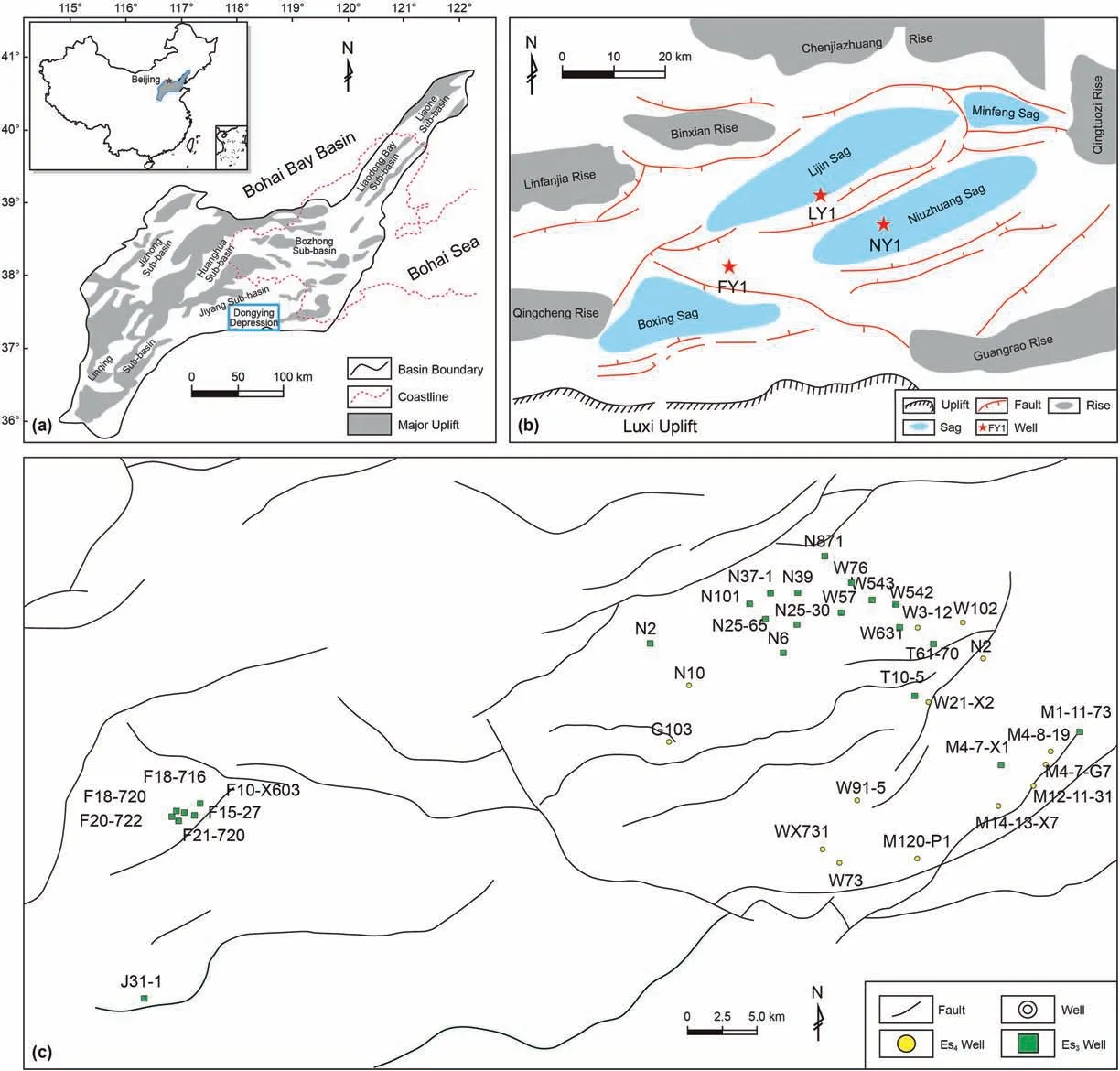
Fig.1. Location map of study area.(a)Schematic map of the Bohai Bay Basin(modified after Zhang et al.,2019);(b)Tectonic setting map of the Dongying Depression showing the uplifts, sags, main faults and core sample locations (modified after Zhang et al., 2019); (c) Oil sample locations in southern part of the Dongying Depression.
A few commonly used molecular parameters from the saturated hydrocarbon fraction in the studied samples are listed in Table 1.The C32H/C31H ratios vary from 0.59 to 0.96 with an average value of 0.72 in the Es3sourced oils;whereas they range from 0.78 to 1.22 with an average value of 0.96 in the Es4sourced oils(Table 1).While some overlap exists between the two sourced oils likely due to mixing of charge (some known mixed oils were excluded in this study),the systematic difference in C32H/C31H may reflect intrinsic differences in source rock depositional environment.However,the differences in bitumens are less obvious. High C32H/C31H ratios occur only in limited samples of the Es4bitumens possibly due to thermal maturity influence. Fig. 3 shows diagrams that compare the C32H/C31H ratio with other parameters that are sensitive to redox conditions and/or organic matter input. The homohopane index (HHI) values, expressed as the percent abundance of C35hopanes relative to the summed C31to C35hopane abundances(Peters and Moldowan, 1991), for the Es3sourced oils are in the range of 2.9%-11.5% (average 6.3%) and those for the Es4sourced oils range from 7.6% to 22.4% (average 14.2%) (Table 1). The difference of HHI among the Es3and Es4bitumens is much less significant with an average value of 7.0% and 8.0%, respectively. A nearly linear correlation between C32H/C31H ratio and HHI was observed for samples having both parameters available (Fig. 3a).
Gammacerane is present in very different concentrations in the studied samples.The gammacerane index,calculated as the ratio of gammacerane to C30hopane (G/C30H), varies between 0.04 and 0.48 in the Es3sourced oils and from 0.63 to 1.1 in the Es4sourced oils (Table 1). Lower G/C30H values were also observed for the Es3bitumens compared to the Es4bitumens. Positive correlation between C32H/C31H and G/C30H ratios is obvious with linear correlation coefficients of 0.66 and 0.69 for the Es3and Es4sourced oils,respectively(Fig. 3b).
Most samples in the present study have phytane concentrations higher than pristane and the Pr/Ph ratio varies from 0.14 to 1.14 in all studied samples. The average Pr/Ph ratios of the Es3and Es4sourced oils are 0.55 and 0.25, respectively, while slightly higher values of Pr/Ph were observed for bitumens with an average value of 0.59 and 0.56 for the Es3and Es4source rocks, respectively(Table 1).Overall low Pr/Ph ratios suggest that Shahejie Formation source rocks are formed under reducing depositional environments. A general negative correlation between C32H/C31H and Pr/Ph ratios occurs in the studied sample suite(Fig. 3c).
4.2. Maturity impact on terpane related parameters
Measured vitrinite reflectance(%Ro)values in core samples from well NY1 are in the range of 0.44%-0.67%,and those from well FY1 and LY1 are 0.48-0.76%and 0.52-0.86%,respectively(Fig.4a)(Ping et al.,2019; Zhang et al.,2019,2020).While the exact value of%Romight be suppressed due to the nature of lacustrine Type I kerogen(Guo et al., 2012), molecular ratios such as Ts/(Ts + Tm) and the ratio of tricyclic terpanes to pentacyclic terpanes(TT/PT)show good correlations with vitrinite reflectance in the studied wells.The TT/PT ratios in well NY1 vary from 0.01 to 0.35,while those from well LY1 increase from 0.1 at 3580 m to 1.14 at 3830 m (Fig. 4b). Depth profiles of Ts/(Ts+Tm)from wells NY1 and LY1 have been plotted in Fig.4c,and this parameter increases from about 0.4 at 3300 m in well NY1 to greater than 0.95 at 3800 m in well LY1. While the organic input and redox conditions have inevitably exerted some influence on TT/PT and Ts/(Ts + Tm) ratios in lacustrine source rocks, good correlation with %Roand depth suggests that thermal maturity plays the dominant role on the variation of these ratios.The Ts/(Ts + Tm) ratios from the Es3and Es4oils are very similar within a range of 0.33-0.54 and 0.30-0.51, respectively. Similarly,all oils have TT/PT ratios below 0.15.Relatively low Ts/(Ts+Tm)and TT/PT ratios suggest generally low maturity of oils in the Dongying Depression.
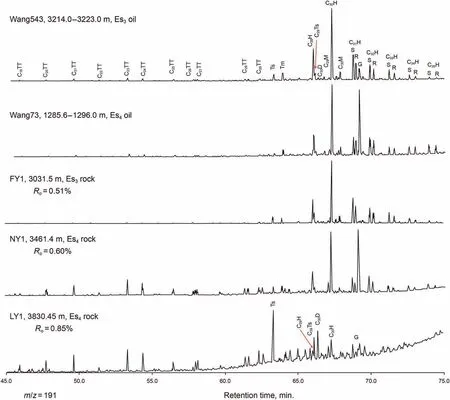
Fig.2. The m/z=191 mass fragmentograms showing terpane distributions in representative oil and bitumen samples from the Dongying Depression.C19-C30 TT:tricyclic terpane;Ts: 18α(H)-trisnorneohopane; Tm: 17α(H)-trisnorhopane; C29H: C29 17α,21β(H) 30-norhopane; C29Ts: C29 18α(H)-30-norneohopane; C30D: C30 17α(H)-diahopane; C29M: C29 17β,21α(H) 30-normoretane; C30H: C30 17α,21β(H) hopane; C30M: C30 17β,21α(H) moretane; C31-C35H: C30-C35 17α,21β(H) homohopane; G: gammacerane.
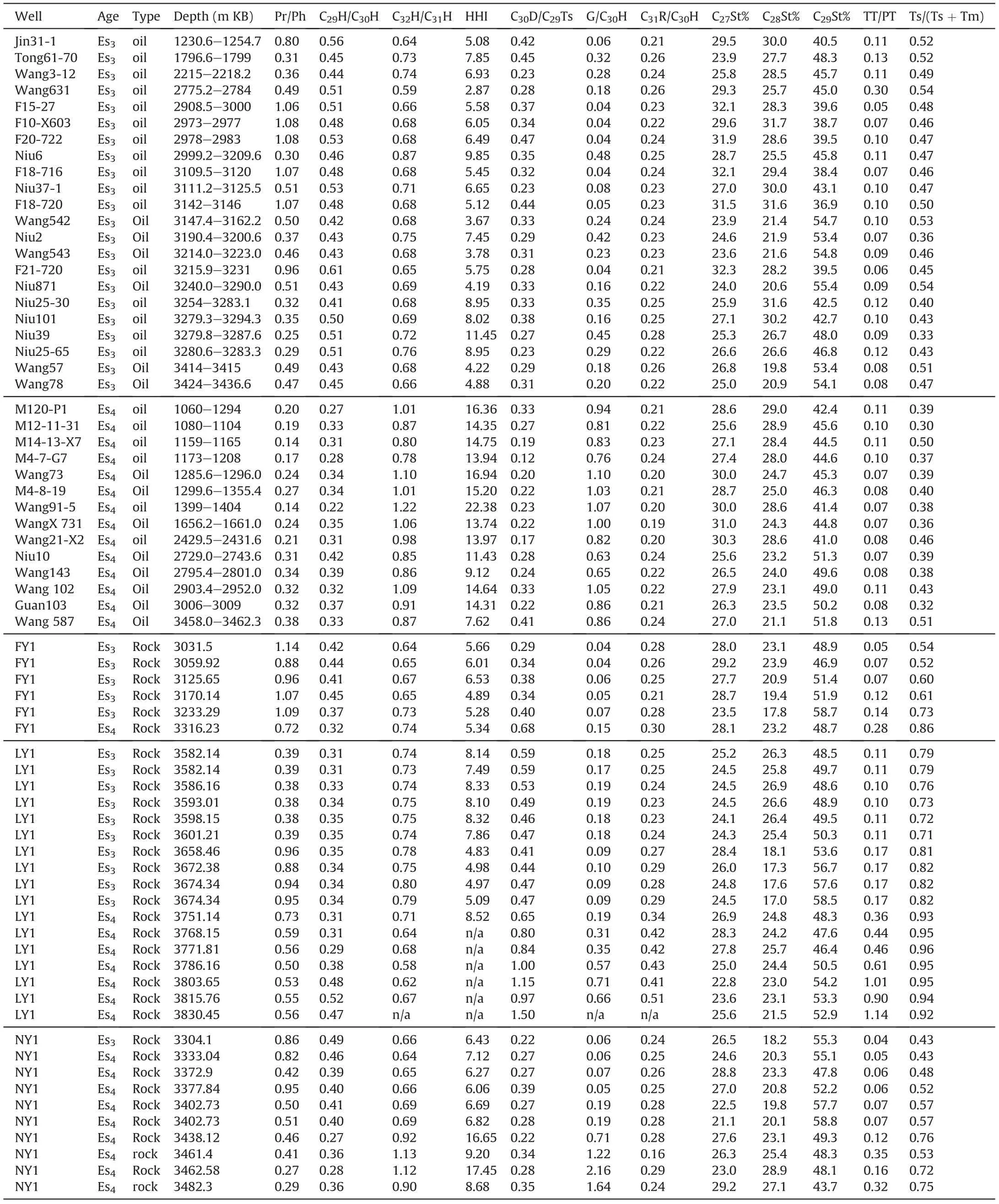
Table 1 Biomarker compositions of oils and source rock extracts from the Dongying Depression.
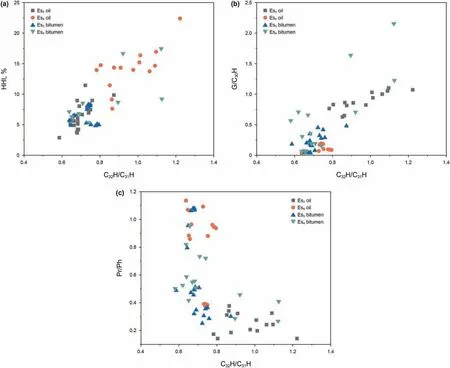
Fig. 3. Plot of C32H/C31H ratio vs. known depositional environment parameters in oil and bitumen samples from the Dongying Depression. (a) Homohopane index (HHI); (b)Gammacerane index (G/C30H); and (c) pristane/phytane ratio (Pr/Ph).
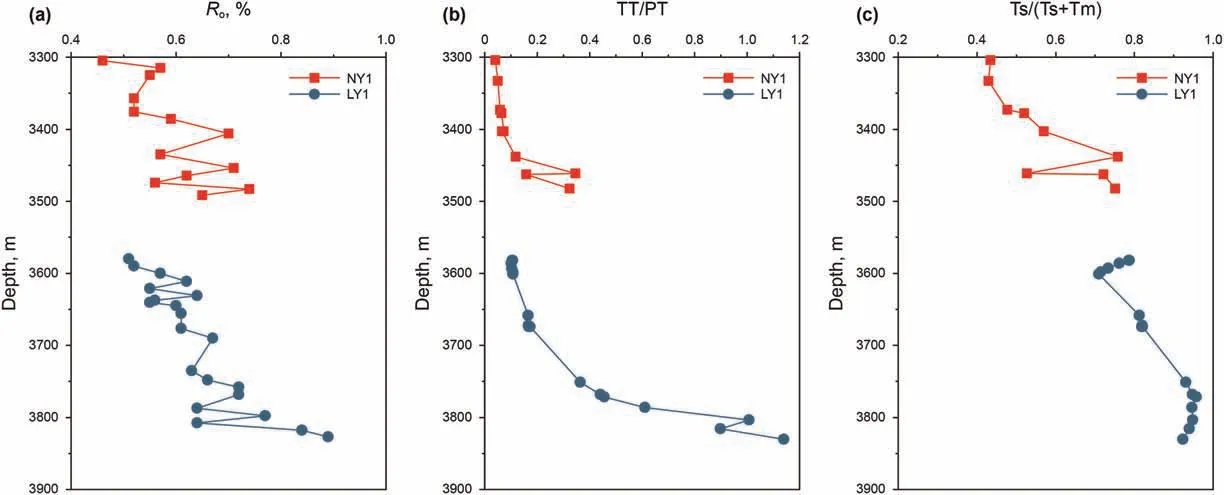
Fig.4. Depth profile of source rock maturity in wells NY1 and LY1.(a)Measured vitrinite reflectance;(b)Concentration ratio of tri-to pentacyclic terpanes(TT/PT);(c)Concentration ratio of Ts/(Ts + Tm).
Here the TT/PT ratio has been applied as a maturity determinant for oils,because vitrinite reflectance cannot be directly measured.A plot of TT/PT and C32H/C31H shows no correlation for the studied oils. However, elevated TT/PT ratios corresponding to low C32H/C31H ratios occur in the bitumen samples, especially the Es4sourced bitumens, indicating preferential cracking of high molecular-weight homohopanes(Fig.5a).The correlation between TT/PT ratio and HHI is also very weak. An issue for HHI is that no reliable C35homohopane can be detected from some Es4bitumens due to high maturity(Fig.5b).Extensive cracking of homohopanes at high maturity makes HHI unusable as a redox indicator in mature source rocks.There is no obvious correlations between TT/PT and G/C30H ratios in all oils and Es3bitumens.However,the Es4bitumens fall in two categories. Some samples have high G/C30H ratios but low TT/PT ratios, reflecting hypersaline conditions (without maturity influence), while others show linear correlation between G/C30H and TT/PT ratios,suggesting maturity related variation due to preferential cracking of C30H (Fig. 5c).
5. Discussion
5.1. Why the C32H/C31H ratio is needed
Redox conditions are known to affect the distribution of terpanes (Peters and Moldowan,1991). Our data from the Dongying Depression illustrate that high values of C32H/C31H correspond with high values of HHI and G/C30H, suggesting that C32H/C31H is sensitive to depositional environment as well. However, HHI and gammacerane index have been applied as depositional environment indicators for decades, why the C32H/C31H ratio is still needed. Our first concern is maturity sensitivity. The thermal maturity influence on HHI is a well-documented phenomenon. In our studied samples, no C34and C35homohopanes can be reliably detected in the Es4bitumens when Rois>0.75%in well LY1,which limits the utility of HHI as redox indicator.The decrease of HHI with increasing thermal maturity has also been reported in related mature oils (Peters and Moldowan, 1991; Vu et al., 2009). While maturity influence on C32H/C31H has not been systematically documented, the mass chromatograms in the Es4bitumens and correlation between C32H/C31H and TT/PT ratios in our studied samples suggest that C32H/C31H ratio suffers similar influence as the C35H/C34H ratio but much less dramatically. HHI was deteriorated at early oil generation stage and no reliable HHI can be obtained from source rocks Ro~0.75%,while reliable C32H/C31H ratio can be calculated up to Ro~1.0%when regular hopanes are largely vanished and the C32H/C31H ratio remains valid until Ro~0.85%in the Dongying Depression. Maturity impact on homohopane distribution and the preferential depletion of the C35homohopanes were well documented in the literature.Pan et al. (2008)reported the results of pyrolysis experiments performed on a source rock(YHS1) deposited in a saline environment. The samples were heated to temperatures of 180, 210, 240, 270, 300, and 320°C during 2 h and isothermally hold for 72 h in a confined system(Au capsules) under 50 MPa. The original sample shows obvious elevated C32and C35homohopanes with C35H/C34H and C32H/C31H ratios of 1.29 and 1.12,respectively.Once heated to 180°C,the C35H/C34H and C32H/C31H ratios drop to 0.93 and 0.99,respectively,with 28% and 12% of reduction. The C35H/C34H and C32H/C31H ratios in pyrolysates at 320°C are 0.89 and 0.82,a 31%and 26%of reduction.Hydrous pyrolysis experiments performed by Peters and Moldowan (1991) for the Monterey shale delivered the similar results. The unheated siliceous member (GC-MS No. 767) has C31to C35homohopanes in relative percentage of 30.8,25.2,17.3,8.0 and 18.7,respectively.Once heated at 290°C,relative percentage of C31to C35homohopanes becomes 38.9, 27.1,17.6, 8.2 and 8.2, respectively. The C32H/C31H ratio drops from 0.82 to 0.7 with 14.5% of reduction,while the HHI and C35H/C34H ratios drop from 18.7 to 8.2 and from 2.3 to 1.0,with 56.1%and 57.2%of reduction.The pyrolysis results are consistent with our observations for the Es4bitumens where no reliable HHI can be obtained when TT/PT ratios are>0.4 and C32H/C31H ratios decrease accordingly with increasing TT/PT ratios. However, much slow reduction of C32H/C31H ratio as compared to HHI and C35H/C34H ratios attests a wider valid range of C32H/C31H ratio during maturation.
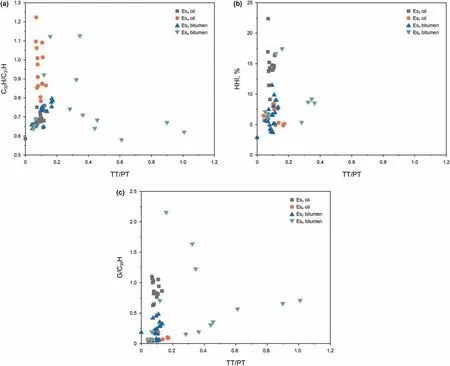
Fig.5. Plot of summed tricyclic terpanes to summed pentacyclic terpanes(TT/PT)ratio with redox condition parameters in oil and rock samples from the Dongying Depression.(a)C32H/C31H ratio; (b) Homohopane index; (c) Gammacerane index.
High gammacerane abundance is a useful indicator of hypersalinity and/or water column stratification during deposition of sediments(Moldowan et al.,1986;Sinninghe Damst′e et al.,1995b).Gammacerane mainly originates from tetrahymanol in bacterivorous ciliates living in hypersaline water(Ten Haven,1989).High G/C30H ratios in the Es4bitumens and related oils (Table 1) reflect salinity stratification and are a marker for photic zone anoxia during source rock deposition, which is supported by the high sulfur content of the Es4oils(Zhan et al.,2019).Low gammacerane index values (G/C30H generally < 0.4) in the Es3bitumens and related oils indicate no stratified water or very low salinity in the palaeolake during the deposition of sediments. However, gammacerane is thermally more stable than C30hopane. Once hopane thermal cracking was initiated, gammacerane index increases linearly with maturity (Fig. 5). Zhang et al. (2020) noted that some abnormally high gammacerane indexes in bitumens might be caused by preferential cracking of C30H and cannot be regarded as a proxy for depositional environment in the Dongying Depression.While maturity inevitably affects relative abundance of C31and C32homohopanes, thermal stability difference between them is less significant than the difference between C30H and gammacerane(Peters et al., 2005), which makes validity range of the C32H/C31H ratio less sensitive to maturation than the G/C30H ratio.
The second consideration is biodegradation influence. Homohopane distributions can be altered by biodegradation.Peters et al.(1996) demonstrated that biodegradation can result in selective loss of low molecular weight homologs, while C35homohopanes are more resistant.The HHI increase dramatically with the extent of biodegradation because C35homohopanes are demethylated less readily than their lower homologs. Similarly, gammacerane has much higher ability to resist biodegradation than other regular hopanes and becomes the dominant component in the m/z 191 mass chromatograms of heavily biodegraded oils (Zhang et al.,2014; Huang and Li, 2017). While heavily biodegraded oils have not been selected in the present study,selective preservation of C35homohopanes and gammacerane have been noted from biodegraded oils in the Dongying Depression (Wang et al., 2013).However, biodegradation preference between C31and C32homohopanes is much less distinctive compared to compounds in the HHI and G/C30H.Therefore,the C32H/C31H ratio is more robust than HHI and G/C30H in heavily biodegraded oils.
The third advantage to use the C32H/C31H ratio is its sensitivity in redox conditions. High C35-homohopane indices are typical of marine, low Eh environments of deposition. The elevated C35-homohopanes for the lacustrine oil indicate a highly reducing source rock depositional environment, most likely related to hypersalinity during the deposition. However, in anoxic, freshwater lacustrine environments, this enhanced preservation of higher hopane homologs does not occur,probably because the appropriate mechanism for sulfur incorporation is not operative (Peters and Moldowan,1991). Therefore, low C35-homohopane index does not imply the oxic depositional system. Similarly, high gammacerane index may reflect hypersaline and strong reducing conditions in lacustrine depositional system, but low gammacerane index does not necessary reflect oxic conditions.On other hand,the C32H/C31H ratio can differentiate reducing from oxic depositional environments in a similar manner as Pr/Ph ratio. The Pr/Ph ratio is one of the most commonly used geochemical parameters and has been widely invoked as an indicator of redox conditions in the depositional environment and source of organic matter (Didyk et al.,1978). Organic matter derived from terrigenous plants would be expected to have high Pr/Ph ratios of>3.0(oxic conditions),while organic matter formed under anoxic conditions normally has low Pr/Ph ratios of < 1.0 (Didyk et al.,1978). Similarly, high C32H/C31H ratio (> 0.8) indicates reducing conditions, while low C32H/C31H ratio (< 0.8) reflects suboxic conditions and extremely low C32H/C31H ratio (< 0.4) is indicative of strong oxidation environment such as coal seam deposition (see further discussion in next section).
5.2. Does C32H/C31H ratio work for other petroleum systems
The geochemical significance of the C32H/C31H ratio as a redox proxy needs more supportive data from different environments.Here are a few case histories documented in the literature.Pan et al.(2008)reported six Oligocene lacustrine source rock samples from the Qaidam Basin, NW China. Those samples are formed under sulfidic conditions in the Ganchaigou Formation and are thermally immature near the oil generation threshold. They found that C31-C35homohopanes show unusual distribution patterns. In addition to high C35H/C34H ratios ranging from 1.27 to 3.42(average 1.91),five samples have the C32H/C31H ratios>1.0 with the highest value of 1.69(average 1.31).The co-variation of the C32H/C31H and C35H/C34H ratios provides supportive evidence that elevated C32H/C31H ratio(>1.0)can reflect highly reducing environment(Fig.6a).Gülbay and Korkmaz(2008)documented the Tertiary immature oil shale deposits in NW Anatolia, Turkey. The Miocene Beypazarı oil shale is unconformably set above the Paleocene-Eocene redcolored clastic deposits and interbedded with lignite. The Oligocene Bahçecik oil shale consists of marl,shale and tuff.Himmeto˘glu and G¨olpazarı oil shales are normal clastic deposits formed in the Paleocene-Eocene and Oligocene,respectively.Those oil shales are typically characterized by high hydrogen index and low oxygen index values. The relationship among HHI, G/C30H and C32H/C31H explored here may further clarify the reducing intensity. Both C33and C34homohopanes are absent in the Himmeto˘glu and G¨olpazarı oil shales but C35homohopanes were well preserved, whereas no C35homohopanes can be detected from the Beypazarı oil shale and the C35homohopanes are lower than C34homohopanes in the Bahçecik oil shale (Fig. 6b). The G/C30H ratios in the Himmeto˘glu and G¨olpazarı oil shales are 0.32 and 0.31, while values for the Beypazarı and Bahçecik oil shales are 0.13 and 0.08, respectively.The C32H/C31H ratios in the Himmeto˘glu and G¨olpazarı oil shales are 1.80 and 0.81, while values for the Beypazarı and Bahçecik oil shales are 0.74 and 0.42, respectively. All HHI, G/C30H and C32H/C31H values suggest that Himmeto˘glu and G¨olpazarı oil shales were formed under stronger reducing environment than Beypazaran and Bahçecik oil shales.
Peters and Moldowan (1991) reported a suite of Monterey oils from offshore California.The Monterey Formation was deposited in silled marine basins under highly reducing conditions without hypersalinity. The gammacerane occurs in very low abundance in these oils. The C35H/C34H ratios in all oils are >1.0, whereas the C32H/C31H ratios are in the range of 0.88-1.08(average 0.95).Only one low mature sample(#549 in original paper)out of nine studied oils has C32H/C31H ratio>1.0(Fig.6c).Data from the Monterey oils may suggest that hypersalinity likely facilitates the preservation of C32homohopanes, although maturity interference with the distribution of homohopanes cannot be ruled out.
ten Haven et al. (1988) studied the Messinian marl (late Miocene)formed in an evaporitic basin from Utah,USA.All samples have very low Pr/Ph ratios (< 0.1), high abundance of gammacerane, and extended hopanes maximizing at C35, indicating hypersaline environments.While no relative abundance of homohopanes has been mentioned in the original paper, elevated C32homohopanes with C32H/C31H ratio > 1.0 was illustrated in the m/z 191 mass chromatograms for the Rozel Point oil (Fig. 2 in Ten Haven et al.,1988). Mello et al. (1988) studied a wide range oils from the major Brazilian offshore basins.Group III oils are characterized by a slight even/odd preference of n-alkanes, the predominance of phytane over pristane, high concentration of gammacerane, and C35H/C34H ≥1.0.Inferred depositional environment for the source rock of this oil group is marine evaporitic under hypersaline conditions. Again, no C32H/C31H ratio has been measured in the original paper, but the m/z 191 mass chromatograms for Group III oils show similar abundance of C31and C32homohopanes (Fig. 4 in Mello et al.,1988).
On the other hand, samples from typical oxic depositional environments have very low C32H/C31H ratio.Peters and Molddowan(1991) used the Brac and Famoso bitumens derived from oxic carbonate sediments as a reference for HHI variation.Their C35H/C34H ratios are 0.50 and 0.65,respectively,and C32H/C31H ratios are 0.46 and 0.71, respectively (Fig. 6d). Both C35H/C34H and C32H/C31H ratios are systematically lower than these formed under highly reducing conditions. Wang (2007) recorded anomalous hopane distributions in marine sediments of the Meishan section at the Permian-Triassic boundary. While no full homohopane distribution has been documented, the C32H/C31H ratios in 67 samples ranging from 0.38 to 0.72(average 0.57),showing typical feature of hopanes in coals and soils. These hopanes were originated from acidified soil and peat and signified the end-Permian mass extinctions and marine ecosystem collapse(Wang,2007).A coal from early Eocene in the Fushun Basin,North China has been illustrated in Fig.6d for the comparison purpose.It is a low maturity coal with vitrinite reflectance about 0.5%. The C31homohopanes account for 82%of extended hopanes and the C32H/C31H ratio is only 0.15.The unusual enrichment of C31-homohopanes results in extremely low C32H/C31H ratio (< 0.4) is a defined terrigenous organic matter,especially in coals and soils under strong oxic conditions.
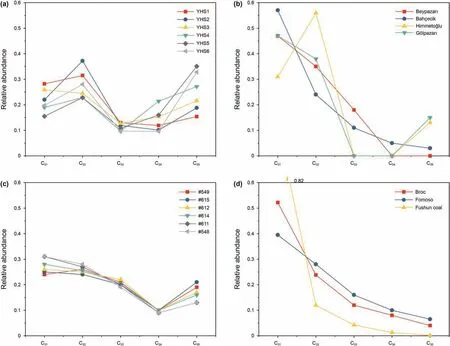
Fig.6. Homohopane distributions for bitumen and oil samples deposited under different redox conditions.(a)Tertiary saline lacustrine bitumens from the Qaidam Basin(data from Pan et al., 2008); (b) Tertiary oil shale bitumens in NW Anatolia, Turkey (data from Gülbay and Korkmaz, 2008); (c) Monterey oils from offshore California (data from Peters and Moldowan,1991); (d) Oxic carbonate (data of Brac and Famoso bitumens from Peters and Moldowan,1991) and coal.
A plot of C32H/C31H ratio vs. HHI using above mentioned case studies shows positive correlation,indicating that both parameters can be applied for redox condition assessment(Fig.7).Limited data in the present study (Fig. 4a), coupled with these published in literature, show a clear boundary between strong reducing and suboxic conditions at C32H/C31H ratio of 0.8,whereas a boundary of redox conditions is difficult to define on the base of HHI.
5.3. Mechanisms for the C32H/C31H ratio as a redox proxy
The mechanisms for the C32H/C31H ratio as a redox proxy are generally similar to HHI but operate in slightly different ways.Preferential preservation of C35homohopanes was attributed to the incorporation of sulfur into the bacteriohopanoid side chain during diagenesis, which mainly occurs in marine sediments formed under anoxic depositional conditions (Peters and Moldowan, 1991;Sinninghe Damst′e et al.,1995a).Abnormally high HHI encountered in lacustrine saline/hypersaline sediments(Fu et al.,1990),such as the Es4bitumens and related oils,may share the same mechanism as the marine one,where sulfurization prevails in the organic-rich source rocks. However, this enhanced preservation of C35homohopanes does not occur in freshwater sediments deposited under oxic or suboxic conditions. A narrower carbon number range of homohopane distributions commonly ranging from C31to C33and relatively lower HHI as illustrated by the Es3petroleum system indicate unique freshwater bacterial and/or terrigenous organic matter input.
The C32H/C31H ratio is most likely controlled by the availability of free oxygen during the deposition of sediments. As homohopanes are mainly derived from bacteriohopanetetrols,diagenetic and catagenetic alteration during burial result in complex reactions including sulfurization, cyclization, side chain cleavage and condensation(K¨oster et al.,1997).Farrimond et al.(2003)revealed that both Priest Pot(freshwater lake)and Framvaren Fjord(sulfidic)samples released high amounts of C32and C35bound homohopanes by hydropyrolysis from kerogen, but the relative abundance of C35homohopanes is much higher for samples from Framvaren Fjord than that from Priest Pot.The C30and C35are biohopanoids incorporated into the kerogen, while C32hopanoic acids and hopanols are the main diagenetic products.Richnow et al.(1992)noted that oxygen-linked hopanoids showed a greater proportion of sidechain shortened homologs, which is consistent with early diagenetic products that had become incorporated into the macromolecular structure. Thiel et al. (2003) found high concentrations of free C32bis-homohopanoic acids occur in microbial mats at methane seeps in anoxic Black Sea waters. All these pointed out that the C30,C32,and C35hopanoids(mainly acids and alcohols)are primary products from biomass (mainly bacterials), while the C31,C33, and C34are likely derived by side-chain cleavage of higher molecular weight hopanoids under different diagenetic conditions.The carboxyl group in C32hopanoic acids might be reduced to C32-homohopanes under anoxic conditions without the change of carbon number, otherwise, the carboxyl group would be oxidized to CO2and form C31-homohopane if free oxygen was available(Peters and Moldowan,1991).Therefore,the free oxygen availability plays the dominant role govern the change of C32H/C31H ratio, which is sensitive to oxic vs.anoxic conditions for organic matter preserved in sediments and related oils. As free oxygen is typically absent in sulfidic environment, the positive correlation between C32H/C31H ratio and HHI as illustrated in Figs.4a and 7 is expectable.
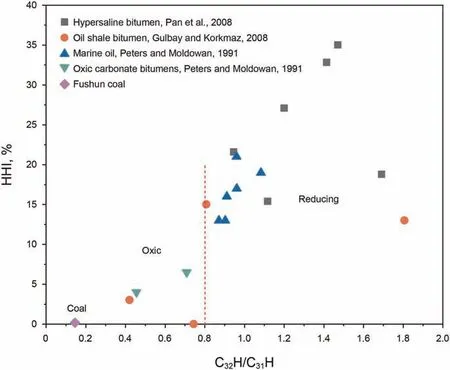
Fig. 7. Plot of HHI vs. C32H/C31H showing redox condition variation.
6. Conclusions
Source rocks of the Eocene Shahejie Formation in the Dongying Depression are a result of variable depositional environments. The fourth member (Es4) was formed under highly reducing, sulfidic and stratified hypersaline water.The bitumen and oil derived from Es4are characterized by high abundances of gammacerane, C35homohopanes,and low Pr/Ph(<0.5). The third member (Es3) was formed under dysoxic,brackish to freshwater with relatively more higher-plant input and/or bacterially reworked organic matter.Bitumen and oil from the Es3member show distinct opposite features compared to the Es4counterpart.
The C32H/C31H ratios are reasonably correlated to homohopane index (HHI), gammacerane index (G/C30H) and Pr/Ph ratios, suggesting that C32H/C31H can serve as a novel depositional environment proxy. High C32H/C31H ratios (> 0.8) may indicate sulfidic,anoxic hypersaline conditions,while low ratios(<0.8)reflect suboxic to oxic conditions in brackish to freshwater.
The mechanisms governing C32H/C31H variation are like those for HHI,G/C30H and Pr/Ph but operate in slightly different ways.The availability of free oxygen during deposition likely plays a dominant role on variation of the C32H/C31H ratio. When free oxygen is available under oxic or suboxic conditions, the precursor bacteriohopanetetrol is oxidized to a C32acid, followed by loss of the carboxyl group to form the C31homohopane or, if oxygen is depleted, the C32homolog is preserved.
Although the C32H/C31H ratio can be influenced by secondary alteration such as thermal cracking and biodegradation, it is more robust than HHI and gammacerane index in highly mature and heavily biodegraded oils.Meanwhile C32H/C31H ratio is sensitive to differentiate reducing from various oxic conditions.
Acknowledgments
This work was supported by National Natural Science Foundation of China(Grant number 41873049),China Postdoctoral Science Foundation(2021M700538)and Sinopec Shengli Oilfield Drs.Steve Larter, Ken Peters, Joseph Curiale, Jian Cao and two anonymous reviewers are gratefully acknowledged for their valuable suggestions and comments that substantially improved the quality of the manuscript.
杂志排行
Petroleum Science的其它文章
- A fast space-time-domain Gaussian beam migration approach using the dominant frequency approximation
- Predicting gas-bearing distribution using DNN based on multicomponent seismic data: Quality evaluation using structural and fracture factors
- Reflection-based traveltime and waveform inversion with secondorder optimization
- Determination of dynamic capillary effect on two-phase flow in porous media: A perspective from various methods
- Settling behavior of spherical particles in eccentric annulus filled with viscous inelastic fluid
- Laboratory investigation on hydraulic fracture propagation in sandstone-mudstone-shale layers
